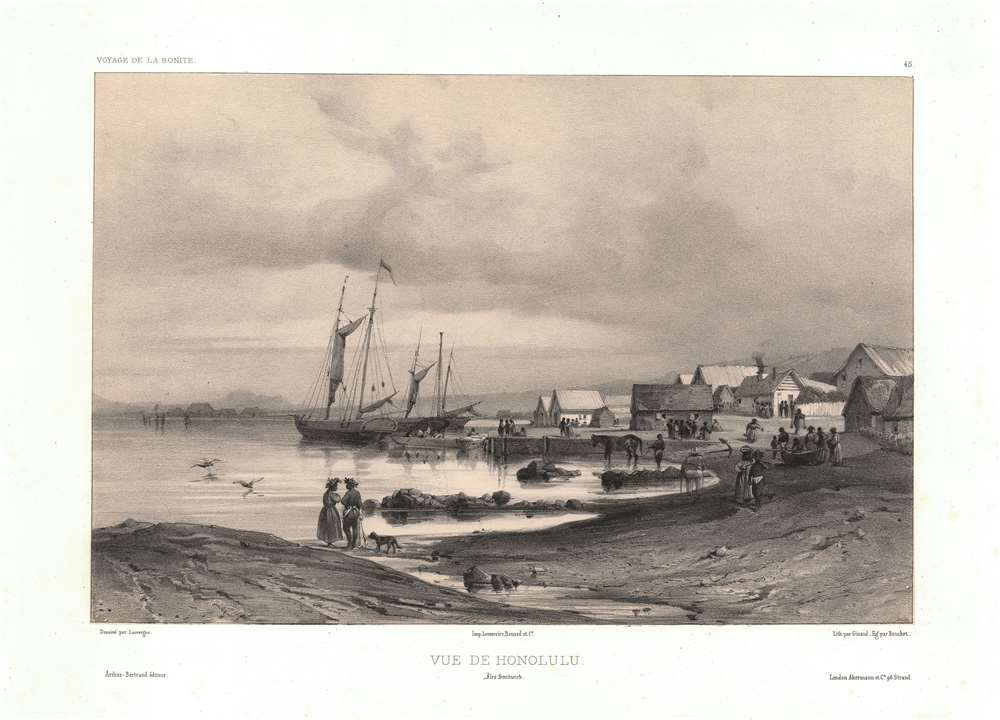This item has been sold, but you can get on the Waitlist to be notified if another example becomes available, or purchase a digital scan.
1841 Lauvergne View of Honolulu, Hawaii
Honolulu-lauvergne-1841
Title
1841 (undated) 9 x 13 in (22.86 x 33.02 cm)
Description
Publication History and Census
This view was originally drawn by Barthélemy Lauvergne in 1836. The view was not published until about 1840, when it was printed for the Album Historique, a collection of maps and views prepared to accompany Auguste Nicholas Vaillant's Voyage Autour du Monde exécuté pendant les années 1836 et 1837 sur la Corvette la Bonit. The Album Historique must have been issued in much smaller quantities than the Voyage Autour du Monde, as it is exceedingly rare, whereas the narrative is only somewhat rare. This view was engraved by Jacques Giuaud and Frédéric Bouchot. It was printed by Lemercier, Benard et Cie., Paris. The view was published jointly by Arthus Bertrand (1840 - 1866) in Paris and Ackermann in London.CartographerS
Barthélemy Lauvergne (July 4, 1805 - November 15, 1871) was a French painter, maritime, and landscape artist active throughout the middle years of the 19th century. Lauvergne was born in Tulon and mastered drawing under Pierre Letuaire (1798 - 1885). He was immediately drawn the exotic and began to travel son after reaching adulthood - circumnavigating the world three times. He first accompanied the French naval officer Jules Sébastien César Dumont d'Urville (1790 - 1842) onboard the L'Astrolabe (1826 - 1829), then Cyrille Pierre Théodore Laplace (1793 - 1875) on La Favorite (1830 - 1832), and finally Auguste-Nicolas Vaillant (1793 - 1858) La Bonite (1836 - 1837). He also participated as an artist on Arctic voyages to Iceland, Spitzbergen, Finland, and Norway. In February of 1841 he was appointed to the Dépôt des Cartes et Plans de la Marine, where with government sponsorship, he published hundreds of finely lithographed images from his voyages - creating unique visual record of cultural interactions between European explorers and indigenous peoples. He painted a portrait of Napoleon III in 1851. Lauvergne retired to his hometown, Toulon, in 1863, and died 8 years later in 1871. More by this mapmaker...
Rose-Joseph Lemercier (June 29, 1803 - 1887) was a French photographer, lithographer, and printer. One of the most important Parisian lithographers of the 19th century, Lemercier was born in Paris into a family of seventeen children. His father was a basket maker, and he even began working as a basket maker at the age of fifteen, but Lemercier was drawn to lithography and printing and soon entered into an apprenticeship with Langlumé, where he worked from 1822 until 1825. After working for a handful of other printers, Lemercier started his own firm in 1828 at 2, rue Pierre Sarrazin with only one printing press. He subsequently moved a few more times before arriving at 57, rue de Seine, where he founded the printing firm Lemercier and Company. He created the firm Lemercier, Bénard and Company in 1837 with Jean François Bénard. Lemercier bought out Bénard's share in the firm in 1843 and, since his two sons died at a young age, he decided to bring his nephew Alfred into the business beginning in 1862, who would progressively take on more and more responsibility in running the firm. Between 1850 and 1870, Lemercier's firm was the largest lithographic company in Paris. The firm began to decline in prestige in the early 1870s, and, after Lemercier's death in 1887, its descent only quickened. It is unclear when the firm closed, but Alfred directed the firm until his death in 1901. Learn More...
Jacques Guiaud (May 17, 1810 - April 24, 1876) was a French painter and engraver known for landscapes, cityscapes, historical scenes, and assorted watercolors. Guiaud was born in Chambéry but grew up in Marseille. He studied painting under landscape artist Louis Étienne Watelet (1780 - 1866) and portraitist Léon Cogniet (1794 - 1880). He was well received, exhibiting at the prestigious Salon annually from 1931 until his death in 1876. He received commission from King Louis-Philippe I, among other dignitaries. In 1865, he was one of several artists selected to decorate the Château de Fontainebleau. Throughout his life, he traveled extensively in Europe. Learn More...
Frédéric Bouchot (1798 - 1860) was a French lithographer and engraver active in Paris during the first half of the 20th century. He worked for the satirical French magazines Caricature, Charivari, and Journal pour Rire. There is considerable debate regarding the date of his death, with estimates from 1840 to 1860. Our own research suggests 1860. Learn More...
Ackermann (1795 - 199x) was a British publishing firm founded by Rudolph Ackermann (April 20, 1764 - March 30, 1834). First known as R. Ackermann and Company, Ackermann's three sons took over the business when their father retired. The firm was known as A. Ackermann and Son in the early 20th century and had offices in London, Paris, New York, and Chicago. Their New York office was exceptionally prolific, issuing work for both the private and government sectors. Ackermann was acquired in late 1990s and the imprint resurrected. Learn More...

